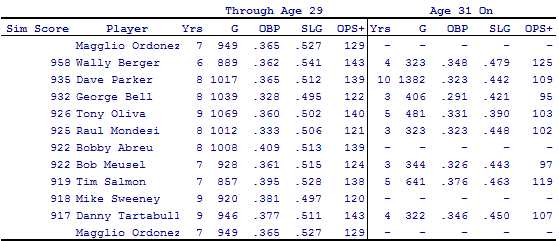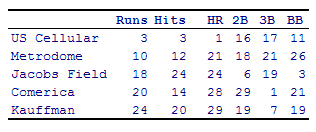With the Tigers interest in Magglio Ordonez, and the confusion over the status of his knee, I wanted to at least get a handle on the chronology of the injury. Below are excerpts from Baseball Prospectus’ Under the Knife report. UTK is written by Will Carroll who has turned himself into the source for baseball injury information.
May 20th
Willie Harris left Wednesday’s game after a collision with Magglio Ordonez. Ordonez also left the game. No report on either player at deadline
May 27th
Ordonez has a moderate strain of his left calf. The injury has been connected to his collision with Willie Harris last week, but it’s unclear if the injury is the result of the collision or a compensation injury after it. Ordonez isn’t a candidate for the DL at this point, but watch his power numbers; if they drop off, it might be a sign that he’s unable to block with his front leg.
June 3rd
I’m not sure if he’s really underrated or just underexposed, but either way he’s a heck of a ballplayer when healthy. Ordonez was sent for a second opinion from Dr. Lewis Yocum on Wednesday. The results must not have looked good since trainer Herm Schneider opened up the possibility of surgery. Ordonez is not yet on the DL, but a retro move is likely. The White Sox had been very patient, hoping that Ordonez could avoid the List, but even if he can avoid surgery he’s going to need the recovery time.
June 4th
Oh…Magglio Ordonez. That’s a different story. He’s the best player on a division-leading team, so news that he’s likely to head under the knife is never a good thing. Ordonez has a significant problem that instead of being his calf is now being reported as a meniscal tear. This would make the pain in his calf something radiating from an entrapped nerve, called “referred pain.” This type of pain is often extremely difficult to diagnose and would certainly explain the confusion of the last few days. If surgery is called for, Ordonez would have it immediately on Friday with team doctors. The rehab would likely take four-to-six weeks, but an All-Star break return looks possible.
June 28th
Ordonez is a few weeks away from returning after knee surgery, but it’s a predictable return.
July 8th
The good news for the Sox is that they will soon get their best player back on the field. Magglio Ordonez will take a quick, low-minor rehab assignment during the ASB and is expected back when the team begins playing again.
July 26th
Bone marrow edema isn’t a diagnosis heard every day. In baseball, it’s now a singular event, afflicting Magglio Ordonez, who just returned from knee surgery. Also called “transient osteoporosis,” the edema is not just a short-term problem for the Sox’ outfielder, it’s also bad in the long-term; BME is a predictor of serious arthritis, gait imbalances, and increased risk for fractures near the affected bones. It’s not good for the White Sox, for Ordonez, or Ordonez’s agent, but it’s not life-threatening, as some have feared. It could be managed in a way that could allow Ordonez back on the field, but as there is nothing with which to compare this, I have no way of putting a timeline on it.
September 23rd
It’s hard to tell what is medical fact and what is negotiation tactic in the case of Magglio Ordonez. The complicating factor of impending free agency gives both parties–player/agent and team–reason to present their spin rather than the facts. Worse, Ordonez’s condition is one that has not only not been seen in baseball, the doctors and trainers with whom I’ve spoken haven’t seen it in sports. So, we’re dealing with an unknown but potentially serious condition, a rehabbing knee that is months behind schedule, and contentious salary negotiations in their last weeks. In other words, absent a miracle, even my best sources really don’t know what the future holds for Ordonez. This is a classic “buyer beware” situation with upside.
September 24
The
he-said/he-said continued between Magglio Ordonez and White Sox GM Ken Williams. As I stated yesterday, we’re dealing with a contentious negotiation, a GM who many have speculated is on the hot seat, and a player dealing with an injury that has not been seen in baseball. Everything must be taken in context, though there is little to give us that needed context. Ordonez asserts that he is healthy, but until he hits the field at some point and demonstrates this, we simply cannot know. Ordonez’s comments must give some optimistic spin to what we know; again, we just don’t have enough information. I hope to have more substantial information on this early next week.
October 19th
Sources with medical knowledge of the Magglio Ordonez situation tell me that Ordonez’s knee is neither as bad nor as good as current news would have you believe. The problem was finally given a solid diagnosis, which includes a second meniscal tear and a reason for the bone edema, giving him a good treatment plan. Ordonez won’t be 100% in December as suggested, though there’s reason to believe that he could be ready for spring training without restriction
November 16th
Your guess is as good as mine. Assurances from agents don’t comfort me much, so until I see Ordonez run, I’ll treat him as injured. This is the ultimate risk for a team: a Scott Boras client with an injury that hasn’t been seen in professional sports. Healthy, he’s an elite level player. I think a bold GM will be rewarded by signing Ordonez.
December 2nd
Knee surgery led to a bone marrow edema, an injury not often seen, let alone seen in baseball players. A second surgery, performed in Austria, has reportedly cleared up the problem. Knee surgery is nearly routine now, so any complication such as the edema is rare. Ordonez was unable to return and now faces questions about his ability to return to his previous performance level. That makes teams reluctant to sign big checks.
Ordonez is reported to have a workout planned for teams during the winter meetings. If he can perform normal baseball activities, there’s little reason to believe he won’t return to his previous levels. Even if he’s not fully healed now, he still has months to go before he needs to be on the field. Add in that Ordonez was not a speed player or rangy outfielder prior to the injury, and the effect is minimal. While knee injuries do have a tendency to recur and need occasional maintenance, there’s no reason to believe that, even if surgery became necessary, the edema or other complications would arise again. A team would be smart to get Ordonez in a room prior to the workouts; if he can walk normally now, sign him. Sometimes you don’t need all the information, just enough to make an informed decision.
December 9th
His knee injuries have been documented both here and elsewhere. About all we don’t know is how he is. A planned workout by Ordonez in Anaheim has been scrapped because Scott Boras feels he’s close enough to a deal that the workout is unnecessary. Enough people have seen the medical records that some team is likely to try to make a move. This is a deal that could well happen this weekend.
January 24th
After a winter of signal silence, facts are finally starting to come out about Magglio Ordonez’s health status. Ordonez had a second knee surgery in Austria, but only secondary to sound-wave treatments on his damaged knee. While the surgery was routine, the sound-wave therapy is controversial. The treatment, similar to those used on kidney stones and plantar fasciitis, is not approved for use in the U.S. Despite reports that his Austrian physician has signed off on Ordonez to return to activity, he has still not yet worked out for any team. I remain hopeful, but he’s a sure red-flag type until he demonstrates he’s healthy.
In summary, it started with a collision. Leg pain prompted further examination where a meniscus tear was identified. Ordonez underwent surgery in June to correct the problem. Typically rehab for this type of procedure is 4 to 6 weeks. All reports are in agreement up to this point.
Various reports indicate that the bone marrow edema was a side effect of the surgery. On 1270AM Scott Boras stated that the edema was the result of Ordonez’s aggressive rehab schedule compounded by the fact that there was another undetected meniscus tear. Boras went onto explain that Ordonez traveled to Austria to see Wolfgang Schaden, and that Schaden repaired the meniscus (Boras equated it to going to the dentist). Boras then said that the edema resolved itself.
Other reports by people who aren’t Ordonez’s agent say that while there was another tear, the reason for the trip was to receive the controversial shock treatment for the edema.
I wish I could tell you more about what the prospects are for a player with bone marrow edema. Unfortunately as Carroll documented there is nobody to compare him to. Studies at Johns Hopkins have indicated that BME is a predictor for osteoarthritis. Other than that I can’t tell you a whole lot.


